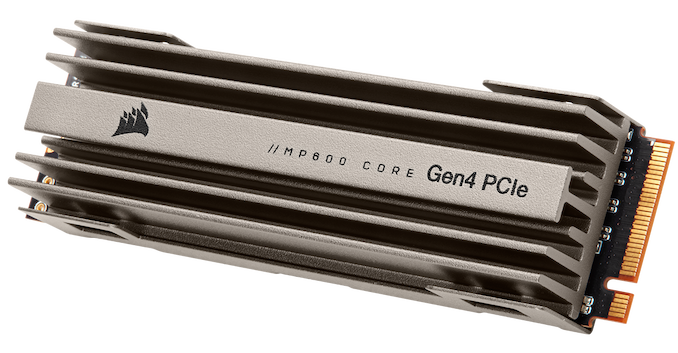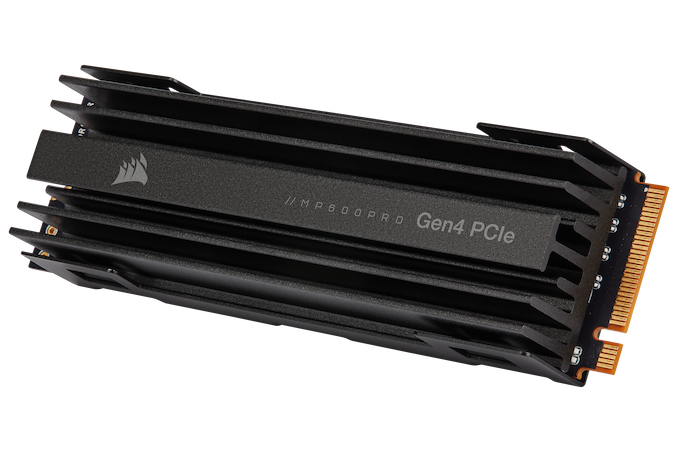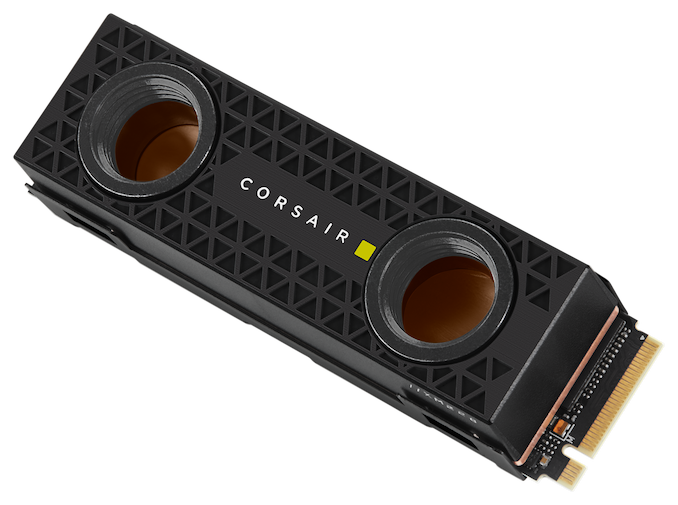Corsair Launches MP600 CORE and MP600 PRO PCIe 4.0 SSDs
by Billy Tallis on January 28, 2021 9:00 AM EST- Posted in
- SSDs
- Storage
- Corsair
- Phison
- NVMe
- QLC NAND
- PS5016-E16
- PS5018-E18

Corsair is launching a new round of PCIe 4.0 M.2 NVMe SSDs based on the latest reference designs from Phison plus Corsair's own heatsink designs. Starting off, the Corsair MP600 CORE is their first PCIe 4.0 SSD with QLC NAND flash memory. This uses the older Phison E16 controller so peak performance only pushes a little bit beyond what would be possible with PCIe 3.0, but it's still a step up from the Corsair MP400.
| Corsair MP600 CORE Specifications | |||||
| Capacity | 1 TB | 2 TB | 4 TB | ||
| Form Factor | M.2 2280 PCIe 4 x4 | ||||
| Controller | Phison E16 | ||||
| NAND Flash | 3D QLC | ||||
| DRAM | 1 GB | 2 GB | |||
| Sequential Read (MB/s) | 4700 | 4950 | |||
| Sequential Write (MB/s) | 1950 | 3700 | 3950 | ||
| Random Read IOPS (4kB) | 200k | 380k | 630k | ||
| Random Write IOPS (4kB) | 480k | 580k | |||
| Power Consumption | Read | 5.6 W | 6.3 W | 6.0 W | |
| Write | 5.7 W | 6.8 W | 7.4 W | ||
| Warranty | 5 years | ||||
| Write Endurance | 200 TB 0.1 DWPD |
400 TB 0.1 DWPD |
800 TB 0.1 DWPD |
||
| MSRP | $154.99 (15¢/GB) |
$309.99 (15¢/GB) |
$644.99 (16¢/GB) |
||
We have a sample of the 2TB MP600 CORE in hand, waiting for its turn to run through our new SSD test suite.
Next is Corsair's new top of the line SSD, the MP600 PRO based on the Phison E18 controller and TLC NAND flash memory. The MP600 PRO takes over the top spot from the original MP600, Corsair's Phison E16 + TLC product that launched in 2019 alongside the first AMD Ryzen CPUs to support PCIe 4.0. The new MP600 PRO will be available with either the standard aluminum heatsink, or with a water block in a variant sold as the MP600 PRO Hydro X.
| Corsair MP600 PRO Specifications | |||||
| Capacity | 1 TB | 2 TB | 4 TB | ||
| Form Factor | M.2 2280 PCIe 4 x4 | ||||
| Controller | Phison E18 | ||||
| NAND Flash | 3D TLC | ||||
| Sequential Read (MB/s) | 7000 | 7000 | TBD | ||
| Sequential Write (MB/s) | 5500 | 6550 | TBD | ||
| Random Read IOPS (4kB) | 780k | 800k | TBD | ||
| Random Write IOPS (4kB) | 360k | 660k | TBD | ||
| Warranty | 5 years | ||||
| Write Endurance | 700 TB 0.4 DWPD |
1400 TB 0.4 DWPD |
TBD | ||
| MSRP | $224.99 (22¢/GB) |
$434.99 (22¢/GB) |
TBD | ||
| MSRP (Hydro X) | $459.99 (23¢/GB) |
||||
The performance specs for the MP600 PRO are pretty similar to other Phison E18 drives, with 7GB/s reads and write speeds limited more by the flash than the controller. The MP600 PRO will initially be available with capacities up to 2TB, and a 4TB model is coming later. The MP600 PRO Hydro X is only offered in the 2TB capacity, but Corsair is also selling the water block separately as the XM2 for $39.99.













37 Comments
View All Comments
Billy Tallis - Thursday, January 28, 2021 - link
It really depends on the SSD whether the controller or NAND is more prone to overheating. For a high-performance PCIe 4.0 drive it would definitely be counter-productive to thermally insulate the NAND, but on the MP600 CORE the E16 controller might be more in need of cooling than the NAND.Beaver M. - Thursday, January 28, 2021 - link
Very misinformed.The controller is always by far the hottest part on an SSD. Without cooler it can go to 100°C and more. NAND doesnt nearly get that hot.
You should not insulate any of them, because then even the NAND will overheat.
A simple heatsink (or tiny ones on each chip) with cheap double sided thermal tape will generally be enough, if there is surrounding air flow by the CPU fan or something. Better to point a small fan right onto it, if you want to be sure its staying cool and wont throttle.
In the first years of NVMe drives (when there werent any coolers available) I put a Raspberry Pi cooler set on the chips, a 50mm fan on a DIY wire mount (which I screwed on the M.2 mount below it) and pointed it at the SSD. Then used the mainboards fan setting so that the fan only turns on when the mainboards temperature goes up. Worked perfectly and even when its running its impossible to hear.
Makaveli - Thursday, January 28, 2021 - link
That is good to know thank you sir.edzieba - Friday, January 29, 2021 - link
Ease of removal is not the point, the issue is it inflates the BOM cost for everyone. Nobody would accept if buying an SSD had a cinderblock zip-tied to it under the logic that 'it is easy to remove' and 'some customers consider it a value-add', it's just pure waste that has no reason to exist, like RAMsinks.If you look at Puget systems' comparative testing of an bare drive vs. a heatsinked drive (most reviews only test drive temperature and ignore any performance testing over time) - https://www.pugetsystems.com/labs/articles/Samsung... - pay attention to the drive time vs. read/write rate before any throttling occurs, to see just how many continuous gigabytes you need to slam the drive with before any measurable performance change occurs. Along with the ineffectiveness of bar-heatsinks vs. just a small volume of airflow. If you need to read at 2.5GB/s for 120 seconds, that means in any case where you're reading a file smaller than 300GB your heatsink is doing nothing. Or for any random read/write scenario which is the key benefit of an SSD, additional cooling does nothing regardless of workload or duration. You basically need to be running a benchmark torture-test before you gain any 'benefit' from adding extra cooling hardware to your SSD, and if you are doing that it makes more sense to just make sure a case fan is blowing over it than to strap a heatsink to it. SSD heatsinks are bunk.
Beaver M. - Thursday, January 28, 2021 - link
I am really curious how the E18 SSDs will perform in real life tests.Running benchmark programs really are pointless on SSDs, because controllers are configured differently for different tasks, so it might perform better on some things, but worse on others. Real life tests show you where they are really good at.
Even if you want to copy files around all the time, then you also only need to run a real life test moving files of different sizes and contents around for testing.
And testers really should start testing many different (!!!) games how their loading times will differ with each SSD.
FunBunny2 - Friday, January 29, 2021 - link
SLC/MLC/TLC/QLC conundrum. anyone old enough to remember when Bill Gates dismissed warnings about Windows: 'let the hardware fix it' same sort of thing here, except the SSD vendors are going to other way round - let the software demand extreme amounts of storage. without ever more bloated software, games mostly I'd guess, there'd be no need. streaming, that too.xpclient - Saturday, January 30, 2021 - link
I am curious - is there any standardization in form factor of PCIe Gen 4 SSDs with a heatsink to know quickly if they will fit in laptops - at least gaming ones if not the thin and light variety? Intel Tiger Lake for example support PCIe Gen 4 so while currently PCI 4.0 SSDs are on the pricier side, one could upgrade them later when they become affordable but assuming that they will actually fit with the heatsink.